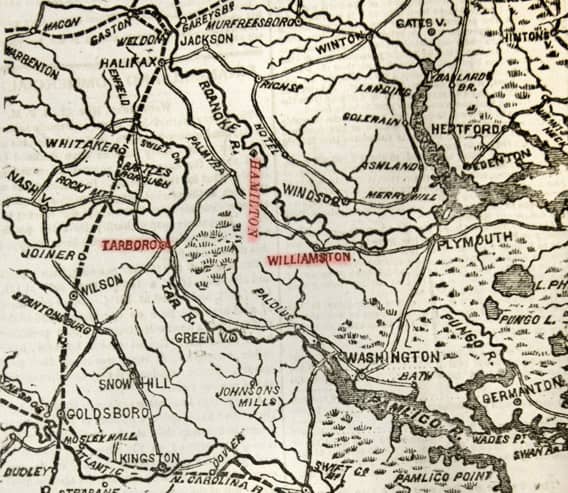
Portion of map of North Carolina published in The New York Herald 13 Nov 1862. (Towns raided by Union forces under Brig. Gen. John Foster are highlighted.)
November 2, 1862 – November 15, 1862
By Phil Kohn (Phil Kohn can be reached at USCW160@yahoo.com.)
On November 2, 1862, in North Carolina, some 5,000 Federals under Brig. Gen. John Foster launch a raid toward Tarboro, destroying the towns of Williamston and Hamilton along the way. The raiders return to Union lines near Plymouth, North Carolina, on November 10.
November 4 is Election Day in the U.S. A war-weary electorate gives generally anti-war Democrats large gains in federal and state voting, although Republicans hold onto their majority in the U.S. House of Representatives. Gains by Democrats are notable in Illinois (home state of President Lincoln, a Republican), New Jersey, New York and Wisconsin. In the West, on the same day, Federal troops capture La Grange, Tennessee, as Maj. Gen. Ulysses S. Grant begins to move on Vicksburg, Mississippi, on the Mississippi River. In Georgia, Federal troops destroy the Confederate saltworks at Kingsbury.
Finally reaching the limit of his patience at the inactivity of the Army of the Potomac, President Lincoln, on November 5, orders Maj. Gen. George McClellan relieved of command, to be replaced by Maj. Gen. Ambrose Burnside. Burnside, neither seeking the job nor happy to get it, tries to turn down the appointment but is unsuccessful.
In the South, on November 6, James Longstreet and Thomas “Stonewall” Jackson are each promoted from the rank of major general to that of lieutenant general, commanding the First Corps and the Second Corps, respectively, of the Confederate Army of Northern Virginia under Gen. Robert E. Lee.
On Nov. 7, the 50,000-strong U.S. Army of the Cumberland, led by Maj. Gen. William Rosecrans, arrives at its new headquarters in Nashville, Tennessee. Back in Virginia, a courier delivers to Maj. Gen. George McClellan the orders relieving him of command. Taken completely by surprise, McClellan works hard to prevent others from seeing his shock. He later writes: “I am sure that not the slightest expression of feeling was visible on my face.”
November 9 is a busy day. Maj. Gen. Nathaniel Banks receives orders to replace Maj. Gen. Benjamin Butler — known by residents of New Orleans, Louisiana, as “The Beast” — as military commander in the Crescent City. Banks’s orders include the statement: “The President regards the opening of the Mississippi River as the first and most important of our military and naval operations.” In Virginia, Maj. Gen. Ambrose Burnside takes command of the Army of the Potomac and re-organizes its now 120,000 soldiers (it had been larger) into three “Grand Divisions.” The Grand Divisions — each comprising two army corps — are headed by Maj. Gens. Edwin Sumner, William Franklin and Joseph Hooker. Federal cavalry, led by Capt. Ulric Dahlgren, makes a quick foray into Fredericksburg, Virginia.
In Warrenton, Virginia, on November 10, Maj. Gen. George McClellan bids farewell to the soldiers of the Army of the Potomac. “Little Mac,” well-liked and respected — even idolized — by his troops, never receives another field command.
In one of their first moves toward Vicksburg, Maj. Gen. Grant’s Federal troops capture a railroad depot near Holly Springs, in northern Mississippi, on November 13. In Tennessee, there is skirmishing between Federals and Confederates near Nashville.
Feeling pressure to “do something,” the newly appointed commander of the Army of the Potomac — Maj. Gen. Ambrose Burnside — on November 14 sets in motion a plan: He will attack Robert E. Lee’s Confederates at Fredericksburg, Virginia. He feels the move will be a steppingstone to an assault on the Confederate capital of Richmond, some 60 miles farther south. (The bulk of Lee’s force comprises Longstreet’s 40,000-man First Corps, at Culpeper, some 35 miles northwest of Fredericksburg, and his like-sized Second Corps, led by Stonewall Jackson, at Winchester, Virginia, in the Shenandoah Valley, some 80 miles away.)
In Richmond, Virginia, on November 15, Confederate Secretary of War George Randolph suddenly and unexpectedly resigns. One contributory factor: President Jefferson Davis’s meddling in, and micromanagement of, War Department matters. On the same day, Maj. Gen. Ambrose Burnside begins moving the Army of the Potomac some 37 miles southeastward from its base at Warrenton, Virginia, towards Fredericksburg, Virginia.







